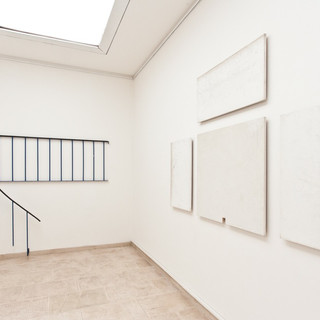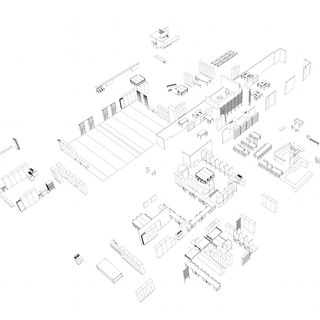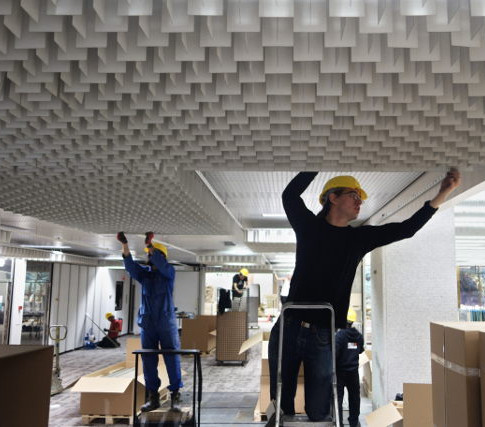PAM Public Lecture | Maarten Gielen: The Big Shuffle
- OLIVIA TAM SIE WEN 1001540443
- Mar 21, 2016
- 7 min read
The title of PAM Public Lectures on 16th March 2016 is 'THE BIG SHUFFLE'. The lecture was conducted by Maarten Gielen.

Maarten Gielen is a member of the Brussels-based collective Rotor. He started his career at the age of 15, selling decorative items made from objects found at scrap merchants and flea markets to fashion stores and florists. Arriving in Brussels in 2002, he set up BSF to offer technical assistance using salvaged materials to small cultural organisations. Two years later, the association merged with the organisations of Zinneke Parade, where he set up a programme for the reuse of industrial waste.

In 2005, he established Rotor where he works as designer, manager, and researcher. Rotor is a collective of people with a common interest in the material flows in industry and construction. On a practical level, Rotor handles the conception and realization of design and architectural projects. On a theoretical level, Rotor develops critical positions on design, material resources, and waste through research, exhibitions, writings and conferences.
At Rotor, he collaborated on exhibition projects including OMA/Progress (Barbican Art Gallery, London, 2011), Usus/Usures (Belgian pavilion at the 2010 Venice Architecture Biennale) and Ex Limbo (Fondazione Prada, Milan, 2011). In 2012 he was appointed visiting professor in the HEAD in Geneva. In 2014 he curated together with Lionel Devlieger the Oslo Architecture Triennale. In 2015 he was awarded with the Rotterdam-Maaskant prize.
During the lecture, he had shared some of the Rotor projects with us.
Case 1 | The Belgian Pavilion at the Venice Architecture Biennale
Rotor represented Belgium's French Community at the 12th International Architecture Exhibition of the Biennale di Venezia. The exhibition Usus/Usures occupied the Belgian pavilion at the Giardini. The project explored wear as a reaction to use in architecture.
The exhibition showcases the relationship between architecture and human occupation. The collective brought poetry, history and emotion to the biennale by focusing on the mundane and the overlooked details of architecture. The exhibition investigates a specific phase in the life of construction materials: the time when they are subjected to use and are gradually re-shaped by human beings passing through them, walking on them, touching, pressing, stroking, scratching or holding them.
The Rotor collective spent years touring public buildings in Belgium to document and collect sections of walls, banisters with chipped paint, wooden floors, stained carpets, tired stairs, elevator cabins, plastic chairs, door handles, windows and other worn out fragments of buildings.
A selection of them hang on the white walls of the pavilion. Taken out of their original context, the objects looks like minimalist sculptures. Rotor’s interest in fatigued bits and pieces of architecture started as a study to evaluate the viability of a resale network for construction and demolition waste. Their concern, however, was not entirely ecological. Like any product, they also elicit an aesthetic evaluation and indeed, an emotional one. Traces of wear play a crucial role in this. They frequently evoke a sense of repulsion from potential buyers, but occasionally evoke attraction and even fascination.
Photography by Eric Mairiaux
With wear and tear, the material gains a new dimension that is both physical and situational.
Case 2 | Student Project at HEAD, Geneva
A group of students were doing experiment about what kind of interesting facts that made people take away the unused material that they usually don’t do and treat them as trash and waste, is it only when unused materials integrated together as a piece of art, then only people will start to appreciate it? The experiment that they carried out includes leaving out some unused building materials such as wall partition. After that, they called the local authorities to pick up those materials, but most of the unused materials were picked up by pedestrians.
Case 3 | Cultural Centre Bomel, Namur

In this project, Rotor acted as matchmakers between a building and its occupants. The building was a freshly renovated 1940’s former slaughterhouse. The future occupants were the team and users of a community arts centre and was run by the Theatre of Namur. It was installed in the heart of the city earlier and now looking forward to move to Bomel. The building is owned by the city and the arts centre was only marginally involved in the follow-up of the renovation project. As a result, there were gaps between the building and the needs it had to fulfill. The renovated 3000 square meter facility was also entirely empty of any kind of furniture such as storage units, tables, chairs, kitchen equipment and toilet roll holders. Rotor’s brief was to provide equipment but also to reflect on how the place would be used and run. Rotor resorted to re-used equipment and materials, found on site, in the commissioner’s stocks, or on the regular second hand market. This is because of a tight budget and also on explicit demand of the commissioner. In addition, they were able to use the full array of materials Rotor was dismantling in parallel on its deconstruction sites elsewhere in Belgium.
The resto-bar of the slaughterhouse has been furnished with elements taken from the cafeteria of the former BNP-Paribas-Fortis Bank headquarters in Brussels designed by Christophe Gevers, famous for his restaurant designs. This allowed the conservation of this unique ensemble. All the storage cabinets of the arts centre with doors in a light-colored wood veneer, come from another dismantled Brussels office building and were carefully numbered, disassembled, trucked, and re-assembled, sometimes transformed on-site. They also designed new gear, such as the 60 ultra-light tables of beech-rimmed sandwich panels resting on aluminum trestles meant to meet with the need for flexibility of the workshop spaces and meeting rooms. Rotor designed them to be as easily moved and stored as possible. Most of the equipment, including the tables, was built by a Rotor team that lived and worked for two months on-site, using the artist residences of the centre to sleep, and a newly installed workshop to work.
Photography by Creative Commons Attribution-Noncommercial-Share Alike 2.0 license by Rotor.
Case 4 | Rotor Deconstruction
Photography by Olivier Beart and Rotor.
After 10 years of research on the flows of materials in industry and construction, Rotor is proud to launch a spin-off: Rotor Deconstruction. This project will become a separate cooperative company, dismantles and sells reusable materials from quality buildings undergoing transformation or demolition. On the one hand, generic construction elements such as doors, windows, lowered ceilings, lighting devises and so on. On the other hand, more exceptional batches of materials from landmark buildings. The "generics" are sold of straight from the deconstruction site. Before starting the dismantling, an inventory of the available materials is made and send to potential clients in a newsletter. The listings allow clients to select the materials they are most interested in. Once the reserved elements are dismantled and duly packaged, clients are invited to come and pick them up or transport is arranged. This method reduces cost of transporting and stocking materials and makes it possible for us to provide quality construction elements at very competitive prices, typically 20 to 50% of new value.
Photography by Olivier Beart and Rotor.
In addition, he also shared some of the aspects that relating to the idea of reusing materials such as “how to manage intangible materials in a design process?” He gave example of the company involved in this stream of work, for instance, Revendous which collects and resell secondhand materials. This company collects and clean the materials then sort them out and later on repackage and sell them. Besides that, demolition has become so common that people actually pay to demolish the buildings. Therefore, people will not appreaciate the reused materials and they only try to use the new materials which will cause a lot of environmental problems. To overcome the problem, Rotor also set up an online-shopping website to publish their products which are made up of reused materials.
For more information on the materials they are selling please refer to the link below.
Personal Review
After attending the lecture, I think I had learnt more about how importance of sustainability it is. The definition of “sustainability” is the study of how natural systems function, remain diverse and produce everything it needs for the ecology to remain in balance. It also acknowledges that human civilisation takes resources to sustain our modern way of life. We now live in a modern, consumerist and largely urban existence throughout the developed world and we consume a lot of natural resources every day. Sustainability and sustainable development focuses on balancing that fine line between competing needs - our need to move forward technologically and economically and the needs to protect the environments in which we and others live. Sustainability is not just about the environment, it is also about our health as a society in ensuring that no people or areas of life suffer as a result of environmental legislation, and it is also about examining the longer term effects of the actions humanity takes and asking questions about how it may be improve. Therefore, we should promote technologies for eco-efficiency, recycling, remanufacturing, reuse of used materials and product durability and longevity so that there is no wastage of valuable resources.
Q&A Session:
Question: Buildings account for approximately 40% of energy consumed, therefore it should be given extra attention to architects in discourse around sustainability. Yet as you've pointed out, a lot of what is stated on the topic of sustainability is pretty shallow. Do you think architecture's role in this discourse has been irreparably compromised?
Maarten: We are making a critique, or trying to take some distance from the subject in order to observe it more clearly. We're not nuking sustainability - we are sincerely interested in the architectural discourse with regard to this topic. Obviously, asking the question whether sustainability can be taken seriously as a concept is controversial in itself, and it is sufficiently controversial so that we can use quite nuanced answers. We don't want to push it to the other extreme either, because there is enough promotion already, but we are not acting as terrorists on this issue. We find all the projects we include in our research genuinely interesting in some way.

Group photo with Maarten Gielen.






































































Comments